La-5 RazorbackBy Aleks Šekularac |
Things were grim in “Zavod 21”. Engineers often say that it is better to be lucky than good, and in Russian aviation industry even better than that, to have strong political ties. It looked like Lavockin ran out of both, luck and ties. The directive came to scrap the “Lakirovannyi Garantirovannyi Grob“(LaGG) and start production of the competitor’s Yak-7 aircraft instead. Lavockin Design Bureau was being reduced to the Yakovlev production facility. To further deepen the gloom, engineers were told to pack their bags, and prepare to move to Tbilisi. It was 1942, Germans were pressing, and uncle Josif orphaned them to the opposed clan. Life must have seamed a bit wretched...
But unlike many classic Russian novels, this tale didn’t end on a tragic note. Lavockin diehards had something hidden underneath Yak-7 blueprints. Their last hope: an old LaGG-3 airframe with new Shvetsov M-82 radial engine strapped on it. A desperate measure for desperate times maybe? In short, this controversial idea, after numerous development and production problems, turned the faiths in Lavockin favor, and ultimately produced one of the most successful fighters of the WWII.
LaGG-3 M-82, dubbed LaG-5, and finally christened La-5 was first in line of Lavockin’s robust radial engine fighters, which will carry Soviet pilots to victory and produce some of the greatest allied aces of the war.
La-5, a significant airplane by any measure, lived for decades in oblivion of the hobby industry. To my knowledge there were no mainstream kits of this aircraft in any scale. Fortunately, some people started thinking that there maybe better things out there then releasing oh-so-much-needed-and-exciting new FW-190A-8 kits every week. I was delighted to come by a perfect pair of companions recently:
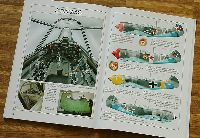 First
things first, the new monograph by MBI is a captivating read about development
and subsequent war service of this pivotal Lavockin design. It covers all La-5
versions (early razorback, F, and FN), including different prototypes and training
aircraft. For those not fluent in Czech, the full text is provided in English
as well. It contains well-written history of the type, rich with details that
bring to life less-than-rosy reality of war; for example whole units of fresh-from-factory
La-5s being thrown into battle and annihilated the same day.
First
things first, the new monograph by MBI is a captivating read about development
and subsequent war service of this pivotal Lavockin design. It covers all La-5
versions (early razorback, F, and FN), including different prototypes and training
aircraft. For those not fluent in Czech, the full text is provided in English
as well. It contains well-written history of the type, rich with details that
bring to life less-than-rosy reality of war; for example whole units of fresh-from-factory
La-5s being thrown into battle and annihilated the same day.
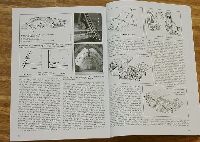 Additionally,
and most importantly, this volume has an excellent technical description of
the airplane, numerous authentic period photographs, color profiles and line
drawings, to satisfy all the avid detail-seekers. This book is simply a single
pit-stop needed for a boost of enthusiasm and knowledge about La-5.
Additionally,
and most importantly, this volume has an excellent technical description of
the airplane, numerous authentic period photographs, color profiles and line
drawings, to satisfy all the avid detail-seekers. This book is simply a single
pit-stop needed for a boost of enthusiasm and knowledge about La-5.
Most people will be familiar with company name Vector through an excellent and ever-growing line of resin engines in all three major scales. Now Vector expands ambitions further, and brings us a full-fledged 1/48 resin kit of Lavockin 5.
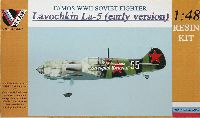 Let
me start by saying that this is very well researched, superbly mastered, beautifully
engineered and produced kit. Resin medium is utilized here in the best possible
way, to the point that not being an injection styrene kit may be considered
an advantage. I am not writing these words lightly.
Let
me start by saying that this is very well researched, superbly mastered, beautifully
engineered and produced kit. Resin medium is utilized here in the best possible
way, to the point that not being an injection styrene kit may be considered
an advantage. I am not writing these words lightly.
Kit comes in a compact top-opening box made of thin cardboard. Company logo and nicely rendered color profile of La-5 adorn the box top. My sample came with further reinforcements made of thick cardboard on the inside of the box. This is very thoughtful considering the uncomforting ways of modern long-distance mail.
Inside the box resin parts are packed in ziploc bags. All part surfaces are smooth, and void of any casting imperfections. Resin is light, elastic, and very “workable” (it can be cut and sanded in a controlled way). All the casting gates are carefully made, so that the parts can be separated with very little effort, and just by applying minimal force.
Fuselage is conventionally split in left and right half, with nose cowling and ruder being separate parts. Inside surfaces show structural detail of the cockpit in full glory.
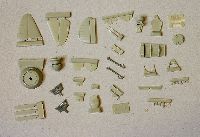 Wing
is cast as a full resin piece, with absolutely straight and sharp trailing edges.
Ailerons are well defined with restrained canvas surfaces and sharp hinge points.
No dihedral and alignment issues, no complicated wheel-bay assembly. This one-piece
“plug and play” wonder is worth a round of applause.
Wing
is cast as a full resin piece, with absolutely straight and sharp trailing edges.
Ailerons are well defined with restrained canvas surfaces and sharp hinge points.
No dihedral and alignment issues, no complicated wheel-bay assembly. This one-piece
“plug and play” wonder is worth a round of applause.
The rest are what I would call small parts, and they are equally well made, if not better. Even the smallest bits, like the trimming wheels, and throttle group for the cockpit are perfectly defined. Pilot’s seat is another impressive piece that will come to life with careful painting and weathering.
Nose cowling is again superbly cast with a nice deep supercharger inlet, gun troughs, and closed engine cooling petals. There are two symmetric pinholes present inside the cooling petals, which I couldn’t explain at first, so I asked Sergey from Vector about them. He kindly replied that these are genuine, and represent openings for Venturi tubes installed behind the shutter, inside the cooling channel. Surely enough, when I checked the drawings and detail photos more carefully, I found these details in place.
Landing gear components are also cast in resin, with excellent detail and appropriate scale thickness. Main legs have steel struts running through them, so there is no fear for structural integrity. Tail wheel fork is however only a fragile resin piece, and this is a concern. Unlike the real aircraft, the model will have a significant part of its weight resting on the tail wheel, so this piece will be highly loaded. Gentle handling after completion of the model will be vital.
The wheel set comes from “Equipage”. My La-5 box is something of a pre-production sample, and it came without wheels, but I hear from Sergey that a set of rubbers is coming my way. Cheers mate;) Another change in “series production” kits, I hear, is inclusion of printed instrument film, to lay under already nice resin instrument panel. Nice touch!
Yet another fine detail is hollow exhaust pipe, cast with part of the exhaust manifold. This will look particularly good with half-open cowling flaps.
What more do you want? How about alternative canopies? Kit comes with two vacu-form pieces: the early double curvature windshield, and the later, flat-panel version. Both are very clear. Sergey tells me that he further improved transparencies for the production version, although mine already look just fine.
Two small omissions in the kit are Pitot-tube and the antenna mast. Discerning modeler will have to produce these from scratch. Mind you, I would much rather make my own Pitot out of steel tubing, then wait for some resin needle to brake. The kit has no age limit written on it, but I doubt that any 8-year-olds will be playing with Vector’s La-5…
Subject selection is another strong point of the kit. There are three decal options, and all of them are superb, well known aircraft.
First one is the box-top selection, and my favorite. White “55” was the personal mount of Arkadii Selyutin -- the 4 GIAP's second ranking ace. It wears “Valeriy Chkalov” dedication on the port side, and the Guards emblem, probably on both sides of the fuselage. Classic Green/Black camouflage is partially covered with worn white distemper, which makes for a challenging airbrushing task, but a stunning model without a doubt.
Second option is equally glamorous. White “75” belonging to 240 IAP was flown by no other than Ivan Kozhedub, greatest allied ace of WWII, It too wears “Valeriy Chkalov” dedication on the port side, and sports classic defensive Green/Black camouflage.
Third one is a winter white La-5 without a number. This one is said to have belonged to a Spanish volunteer pilot, Francisko Meronjo, an ace with 20 victories. The aircraft was adorned with big red inscriptions on both fuselage sides, spelling the name of the Soviet hero, Aleksandar Chekalin.
Decals are printed by Begemont. They are in register, with good saturation and hue. I have no experience with this brand, but I heard positive words from others. I did notice slight yellowing of the decal film on my set. This can be easily corrected by exposing the sheet to sunlight for couple of days. In other words, if you live inside polar circle and it’s wintertime, you are bummed.
All three painting options are given as black and white profiles, without color callouts. Nevertheless, on the VVS web site in the “Research” section one can find all the necessary information (including 3 views for the updated Green/Black disruptive template) to accurately make any of these three options. Therefore you have no excuse...
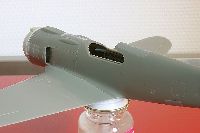 Finally,
I made the acid test, and tried how it all fits. After cleaning the major parts
fuselage halves were taped together, and the cockpit floor clicked in place.
After this, only the light sanding of the joining lines was needed to achieve
perfect fit of the wing-fuselage seam. It almost brought tears to my eyes; if
only Classic Airframes kits had such good fit.
Finally,
I made the acid test, and tried how it all fits. After cleaning the major parts
fuselage halves were taped together, and the cockpit floor clicked in place.
After this, only the light sanding of the joining lines was needed to achieve
perfect fit of the wing-fuselage seam. It almost brought tears to my eyes; if
only Classic Airframes kits had such good fit.
And yes, if you have to ask, it does look like an La-5. You may notice that I didn’t try to compare the parts with any drawings. Sergey tells me that he mastered this model based on drawings by Voronin, and this is enough for me. For my eyes this is the best-looking and most authentic Lavochkin model I’ve seen, and here I consider Gavia and Hobbycraft/Academy offerings too.
Vector’s La-5 is a superb kit from any perspective. It is not made in injection plastic, but this fact should not distract a willing modeler. All resin parts are of the highest standard, and the accuracy and precision surpasses many short run styrene kits in my stash. The single difference in finishing will be to use two-component epoxy glue instead of the classic plastic welder. I do recommend epoxy glue instead of super-glue, for a simple benefit of its slower curing, which can be a big help in aligning major components of the kit.
Vector’s La-5 can be obtained online in two shops:
While I wouldn’t call the kit cheap, the price is quite reasonable in my opinion, considering the quality and exclusivity of the subject.
If you visit one of these two web sites, you will notice that they also have another Vector kit on offer. It is the La-5F. A necessary period of posted packet travel separates me from this new Vector offering. Expectations are indeed high, and I hope I will have another superlative review for you very soon.
I would like to congratulate Sergey and his Vector company for a job well done, and wish him much success in the future. May he bring us many more interesting modeling subjects, made to the same high standard.